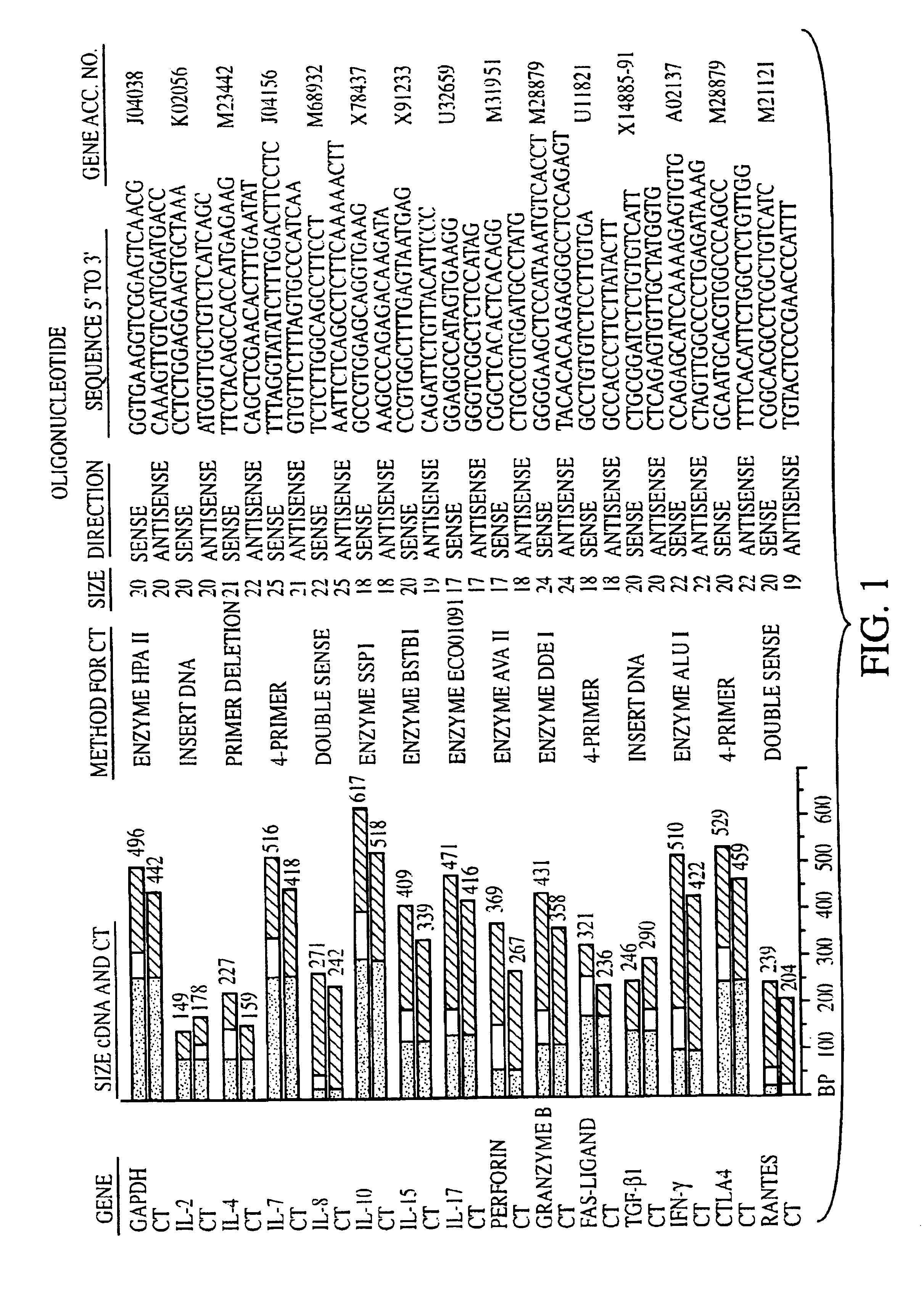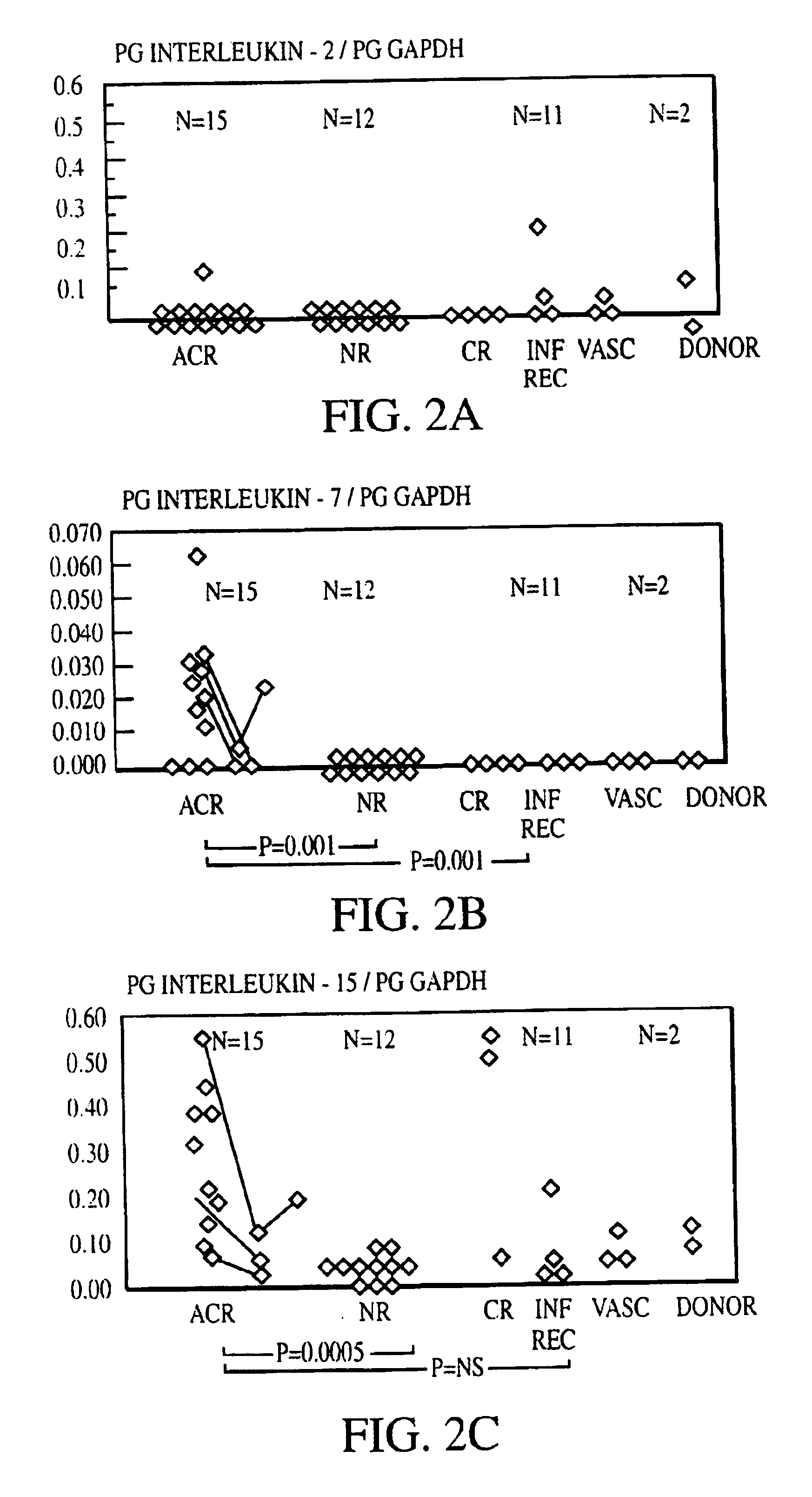Measurement of protective genes in allograft rejection
a technology of protective genes and allografts, applied in the field of allograft rejection measurement, can solve the problems of chronic rejection risk factor, unsuitable current monitoring and diagnostic modalities, and common and serious problems, and achieve the effect of accurately detecting allograft rejection and accurately quantifying marker gene expression
- Summary
- Abstract
- Description
- Claims
- Application Information
AI Technical Summary
Benefits of technology
Problems solved by technology
Method used
Image
Examples
example 1
Analysis of Biopsy Samples
Biopsies:
[0133]Sixty kidney transplant biopsies were investigated for gene expression of chemokines (IL-8, RANTES (regulated upon activation, normal T-cell expressed and secreted), T-cell growth factors and other cytokines (IL-2, IL-4, IL-7, IL-10, IL-15, and IL-17), cell surface immunoregulatory proteins (CTLA4), cytotoxic effector molecules (P, GB, FasL), IFN-γ, transforming growth factor (TGF)-1, and the housekeeping protein glyceraldehyde-3-phosphate dehydrogenase (GAPDH). Thirty-eight biopsies were obtained from 34 patients (25 adults and 9 children) to clarify the cause of graft dysfunction, 20 for early post-transplant surveillance and 2 from living related donor kidneys prior to reperfusion. Small portions of biopsy cores ({fraction (1 / 10)}-½) were immediately snap frozen in liquid nitrogen at the bedside and stored at 70° C. The majority of tissue was used for histopathological analysis. Biopsies obtained to evaluate the cause of graft dysfunction ...
example 2
Analysis of PBMCS
[0147]In a study of 16 renal allograft recipients, PBMCs were isolated from whole blood and RNA extracted by a modified QIAGEN™ method. (QIAGEN Rneasy Blood Mini Kits, Cat. No. 74303, 74304 or 74305). The QIAGEN technique involves four steps: 1) a sample is combined with a suitable buffer for isolating RNA in the sample from the remaining components, e.g., 1 part whole blood, is mixed with 5 parts lysing buffer, wherein the blood cells are lysed and RNA released; 2) RNA in the sample is specifically bound to particles or a membrane; 3) the particles or membrane are washed to remove non-RNA components; and 4) the isolated RNA is eluted from the particles / membrane.
[0148]To increase the efficiency of RNA isolation from PBMCs, the second step of the QIAGEN protocol was modified as described in Example 3.
[0149]Gene expression was analyzed by reverse transcription-assisted semi-quantitative PCR in PMBC and in snap frozen transplant core biopsies and was compared to the hi...
example 3
Method for Processing Blood for PCR Analysis
Supplies:
[0150]2 ml EDTA vacuum tubes (purple top): cat #369651 Vacutainer; Flask with ice.
Procedure:[0151]Label EDTA tubes with Patient ID, date and time.[0152]Draw 2 ml blood into EDTA tube and carefully mix by inversion; transport on ice to the lab to be processed.*
[0153]* For optimal results, blood samples should be processed within a few hours.
White Blood Cell Isolation
Supplies:
[0154]3 cc syringes[0155]15 ml Sterile Conical tubes (Falcon)-Sterile polypropylene tubes (20-200-1000 ul)[0156]RPMI Medium 1640: cat #11875-085 Gibco BRL[0157]EL Buffer: cat #79217 Qiagen[0158]Flask with liquid nitrogen: cat #2123 Lab-Line.[0159]Ethanol (96-100%)-70% ethanol in water[0160]14.5 M-Mercaptoethanol (-ME)[0161]Lab centrifuge with rotor for 15 ml tubes -4C Microcentrifuge with rotor for 2 ml tubes
Instrumentation:[0162]Lab centrifuge with rotor for 15 ml tubes at 4C.
Procedure:[0163]1. Using a 3 cc syringe transfer 1-1.5 ml blood into...
PUM
| Property | Measurement | Unit |
|---|---|---|
| area | aaaaa | aaaaa |
| volume | aaaaa | aaaaa |
| volume | aaaaa | aaaaa |
Abstract
Description
Claims
Application Information
 Login to View More
Login to View More - R&D
- Intellectual Property
- Life Sciences
- Materials
- Tech Scout
- Unparalleled Data Quality
- Higher Quality Content
- 60% Fewer Hallucinations
Browse by: Latest US Patents, China's latest patents, Technical Efficacy Thesaurus, Application Domain, Technology Topic, Popular Technical Reports.
© 2025 PatSnap. All rights reserved.Legal|Privacy policy|Modern Slavery Act Transparency Statement|Sitemap|About US| Contact US: help@patsnap.com



